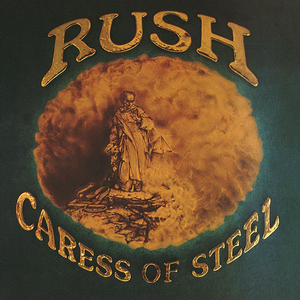
Geddy Lee – Bass
By mid-1975, Rush had stabilised with a line-up of guitarist Alex Lifeson, bassist and vocalist Geddy Lee, and drummer and primary lyricist Neil Peart, who had joined the group in 1974. They released Fly By Night (1975), which marked Rush’s first foray into multi-part conceptual songs with “By-Tor and the Snow Dog”. The group were on a rise in popularity, and received a Juno Award for Most Promising Group. In June 1975, they finished touring Fly by Night, which culminated in a Canadian leg that had them as headliners for the first time.
While preparing their follow-up album, Rush took the extended and conceptual song elements that they had introduced on Fly by Night and made it the central focus for their new material. As a result, this marked a development in their sound from blues-inspired hard rock towards Progressive Rock. Peart recalled that the band approached Caress of Steel feeling “serene and confident” and that all three members were proud of the result. He considered the album a “major step” in their development with its variety of musical dynamics and original ideas. Lee said that the band were “pretty high” while making the album.
The album was recorded in July 1975 at Toronto Sound Studios in Toronto, Ontario. Mixing took place in the same studio.
Songs
Side one
“Bastille Day” concerns the storming of the Bastille during the French revolution.
“I Think I’m Going Bald” was written in reference to Kim Mitchell, lead guitarist and vocalist for Max Webster who shared management and touring.
“Lakeside Park” is about the park of the same name in Port Dallhousie, St. Catharine’s, Ontario, where Peart grew up and worked during the summer as a teenager.
“The Necromancer” is a 12-minute track in three parts. It concerns a necromancer, someone who practices necromancy, a type of divination involving the summoning of spirits of the deceased. The song was influenced by the works of author J.R.R. Tolkien; the necromancer is an alias used by the character Sauron in Tolkien’s novel The Hobbit (1937).
The introduction contains the lyric, “Three travelers, men of Willow Dale”, a reference to the band itself, as Lifeson had formed the first incarnation of Rush in the Toronto suburb of Willowdale. The final section, “Return of the Prince”, sees the return of the character By-Tor from the song “By-Tor and the Snow Dog” on Fly by Night, but in “The Necromancer”, the character is a hero and not a villain. “Return of the Prince” was released as a single in Canada.
Side two
“The Fountain of Lamneth” is the band’s first of three side-long tracks, the others being the title track of 2112 in 1976 and “Cygnus X-1, Book II: Hemispheres” from Hemispheres in 1978. It consists of six parts and tells the story of a man in search of the Fountain of Lamneth as he chronicles the occurrences on his journey. The second part, “Didacts and Narpets”, consists mostly of a drum solo. In 1991, Peart said that the shouted words heard are an argument between the central character and the Didacts and Narpets (anagrams of “addicts” and “parents”, respectively). He could not remember what the words were, “but they took up opposite positions like: ‘Work! Live! Earn! Give!’ and like that.”